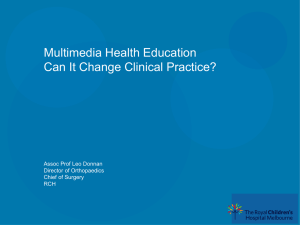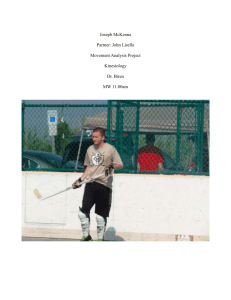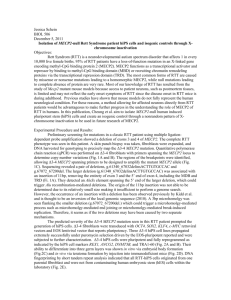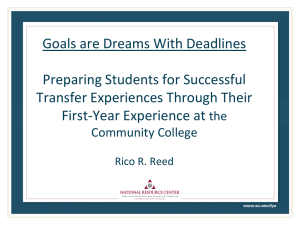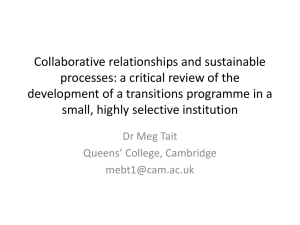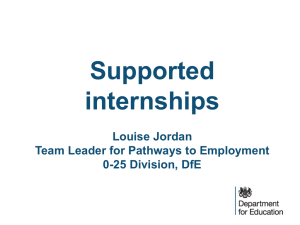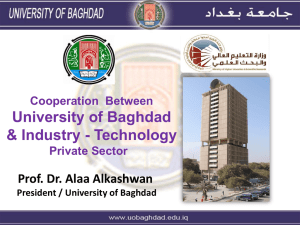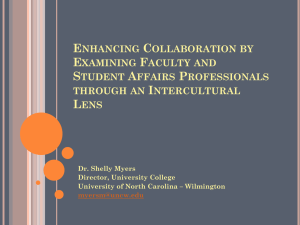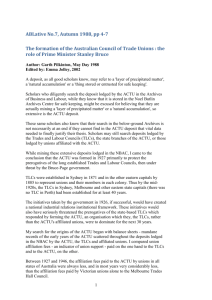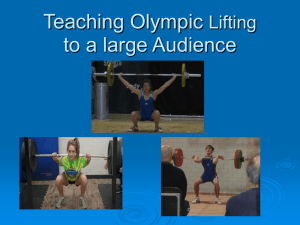Curricular and Co-curricular Engagement
advertisement
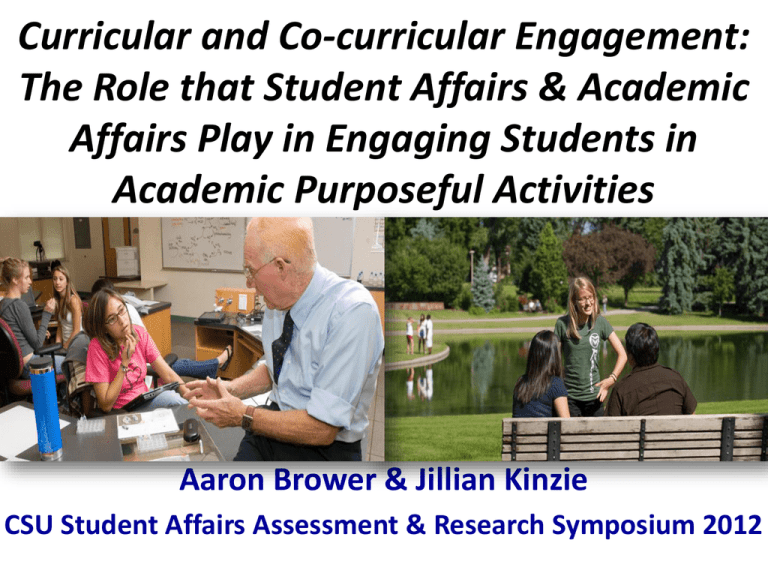
Curricular and Co-curricular Engagement: The Role that Student Affairs & Academic Affairs Play in Engaging Students in Academic Purposeful Activities Aaron Brower & Jillian Kinzie CSU Student Affairs Assessment & Research Symposium 2012 This morning’s session 1. The changing landscape of higher education 2. A vision for higher education 3. How can we best help students learn? 4. Being transparent and accountable Changing Landscape of Higher Education President Obama’s 2020 College Completion Goal “By 2020 America will once again have the highest proportion of college graduates in the world” The Formula: Increase postsecondary access Improve quality Accelerate college completion Assessment & Accountability: Colleges and Universities Increased assessment activity; greater attention to demands of accreditation Emphasis on assessing student learning outcomes More emphasis on engaged learning practices: first year experience programs that support transition, service-learning, internships, and undergraduate research Avoidance of, or reluctant, transparency (Ewell, 2008, 2011; Maki, 2004; Trends in Learning Outcomes, General Education, and Assessment, AAC&U, 2009) Vision for Higher Education Learning as a comprehensive, holistic, transformative activity that integrates academic learning and student development, processes that have often been considered separate, and even independent of each other. Learning Reconsidered (2004) What We Know About Student Learning and Success Educators must be concerned with the learning environment – in and outside the classroom, socio-cultural aspects and physical settings – in which students interact with peers, the content, educators and others, and the implementation of strategies that help guide the student toward the intended outcomes. 6 Commitment to Quality Student Learning Requires institutions to… Set clear goals for student achievement Regularly measure performance against these goals Report evidence of success Continuously work to improve results Committing to Quality: Guidelines for Assessment and Accountability in Higher Education (2012). New Leadership Alliance for Student Learning & Accountability 7 Essential Learning Outcomes Four essential learning outcomes for all graduating students – representing learning beyond the expected professional, technical, and disciplinary expertise – are associated with a high-quality collegiate education. 1. integrative learning 2. personal and social responsibility 3. intellectual and practical skills 4. and knowledge of human cultures and the physical and natural world 8 Designing for Student Learning and Success No matter what program or practice a college implements, it is likely to have a greater impact if its design incorporates the following principles… Design Principles for Student Success A Strong Start Institutional publications accurately describe what students experience Ensure students’ earliest contacts and first weeks incorporate experiences that will foster personal connections and enhance their chances of success Structured Orientation, First Year Experience programs Design Principles for Student Success Clearly Marked Pathways The many choices students face as they navigate college can create unnecessary confusion – create coherent pathways Make plain to students the resources and services available to help them succeed Redundant early warning systems and safety nets Design Principles for Student Success Integrated Support Connect with students where they are most likely to be: the classroom -- build support, such as skills development & supplemental instruction, into courses rather than referring students to services separate from the learning experience Require use of support services (writing center, math tutors) Design Principles for Student Success High Expectations & High Support Students do their best when the bar is high but within reach. Setting a high standard and then giving students the necessary support — academic planning, academic support, financial aid, and so on — makes the standard attainable. Design Principles for Student Learning and Success Intensive Student Engagement Promoting student engagement is the overarching feature Make engagement inescapable for students Value of High Impact Practices High-Impact Practices Educational experiences that make a significant difference to student persistence, learning outcomes, and student success. 1. Educational practices for all students 2. Structural Features High Impact Pedagogical Practices 1. Engagement in effective educational activities in the first year is essential to student persistence & success 17 Effective Educational Practices in the First Year • • • • • • • • • • • • Asked questions in class or contributed to class discussions Made a class presentation Prepared two or more drafts of a paper or assignment Worked with other students on projects during class Worked with classmates outside of class on assignments Tutored or taught other students (paid or voluntary) Participated in a community-based project as part of course Talked about career plans with a faculty member or advisor Discussed ideas from readings/classes with faculty outside class Received prompt feedback on your academic performance Worked harder than you thought Worked with faculty on activities outside coursework (committees, student life, etc.) • Discussed ideas from readings/classes with others • Had serious conversations with students of a different race or ethnicity and those who differ from you - religious beliefs, political opinions, or personal values High Impact Pedagogical Practices 1. Engagement in the first year is essential to student persistence & success 2. “Compensatory Effect” – historically underserved students benefit more than others from the same educational practices High Impact Activities First-Year Seminars and Experiences Common Intellectual Experiences Learning Communities Writing-Intensive Courses Collaborative Assignments and Projects Undergraduate Research Diversity/Global Learning Service Learning, Community-Based Learning Internships Capstone Courses/Projects HIPs Benefits & Outcomes High Impact practices positively associated with: • Persistence and GPA • “Deep approaches to learning” • Higher rates of student-faculty interaction • Increases in critical thinking, writing skills, • Greater appreciation for diversity • Higher student engagement overall, and Bronwell, J & Swaner, L (2010); “compensatory effects” NSSE, (2007); Kuh (2008) HIPs: A Shared Responsibility • HIPs facilitated by a robust partnership between academic & student affairs Be Intentional about Exposing Students to Educationally Effective Practice Recommendation: Make it possible for every student to participate in at least two high impact activities One in First Year • • • FY seminars Learning communities Service learning One Later in Major • • • • Study abroad Student-faculty research Field placement or internship Capstone project Educationally Effective Institutions and High Impact Practices • Introduce HIPs to students early – pre-school and orientation - and reinforce in advising • Weave experiences into courses, and require • Craft short term study abroad, “mini-HIPs” • Emphasize HIPs relevant to the educational environment – i.e., Urban institutions emphasize internships • Encourage pilots & support faculty development • Bridge curriculum and co-curriculum University of Louisville Expand effective educational practices to enhance student engagement and success • Goal: Retain more students; Address their unique needs with intentional programming at each stage of their educational career • Identified existing “high-impact practices” & assessed their efficacy for revision and/or possible expansion • Created Office of Civic Engagement, Leadership and Service - the hub for leadership development, service-learning, and civic engagement activities 26 Inventory and Promote HIPs University of Wisconsin Madison HIPs that have generated demonstrable student outcomes: • In the first year: – FIGS (First-Year Interest Groups) – RLCs (Residential Learning Communities – URS (Undergraduate Research Scholars) • Available Throughout College: – – – – Study Abroad Service Learning/Community-based Research Undergrad Research Student Leadership (in class, such as Peer Mentoring, and out of class, through student organizations) • Some aspects of Gen Ed requirements (Comm A & B, QR-A & B; options for Ethnic Studies Requirement); Honors courses • In the final year(s): – Capstones -- Internships -- Senior Thesis 27 Promote HIPs University of Wisconsin Madison • Intentional promotion of HIPs in Summer Orientation, Advising and Registration (SOAR) • Ensured that Advisors asked students about their interest and intentions about HIPs • Saw increase in number of students making inquiries into study abroad, undergraduate research 28 Themed Learning Communities (TLC) at IUPUI 3 or more linked courses including integrative first-year seminar connected through an interdisciplinary theme TLC Ex: “It’s Not Easy Being Green” First-year students conduct research on environmental issue in Indianapolis. Faculty and instructional team members work together to integrate the curricula Exciting opportunities to integrate high impact programs in meaningful way in first-year curriculum 29 Examples of Undergraduate Research in TLCs “Our Chemical World” First-year students paired with science faculty conducting research. “It’s Not Easy Being Green” First-year students conduct research project on environmental issue in Indianapolis under the guidance of faculty researchers. 30 Service Learning in TLCs 33% Include Service Learning 3 Education TLCs 3 Nursing TLCs 2 SPEA TLCs 2 University College TLCs 1 Liberal Arts TLC 24% Include One Time Service Projects 2 Engineering TLCs 2 Liberal Arts TLCs 2 Psychology TLCs 2 University College TLCs 31 Impact of HIPs: CSU Northridge Conclusion: Multiple HIPs distributed through Gen Ed and majors would, “require only small curricular changes.” Such “modest change” can yield a significant increase in student success and persistence. 32 Assessment • Institutions had more than enough actionable assessment, yet little utilization. • Many steps are needed to train campus leaders to use data – Change something see what happens! www.learningoutcomesassessment.org Emphasize Action & Improvement Use Evidence on Hand! • For assessment to be successful: put aside the question, “What’s the best possible knowledge?” and instead ask, “Do we have good enough knowledge to try something different that might benefit our students?” • “The most fruitful way to learn if the conclusions that we have drawn from assessment data are correct is to try to change something and see what happens.” Blaich & Wise, 2011, NILOA publication 34 Share Evidence and Collaborate on Promising Practices Create sustained conversations about assessment data and engage in sense-making activities on campus, with colleagues, and across institutions 35 To Discuss 1. How has/is your job changing? 2. What effective educational practices, or high-impact practices (HIPs), are most important to your unit? What could be enhanced? 3. What are the benefits and challenges of collaboration between student and academic affairs at CSU?
